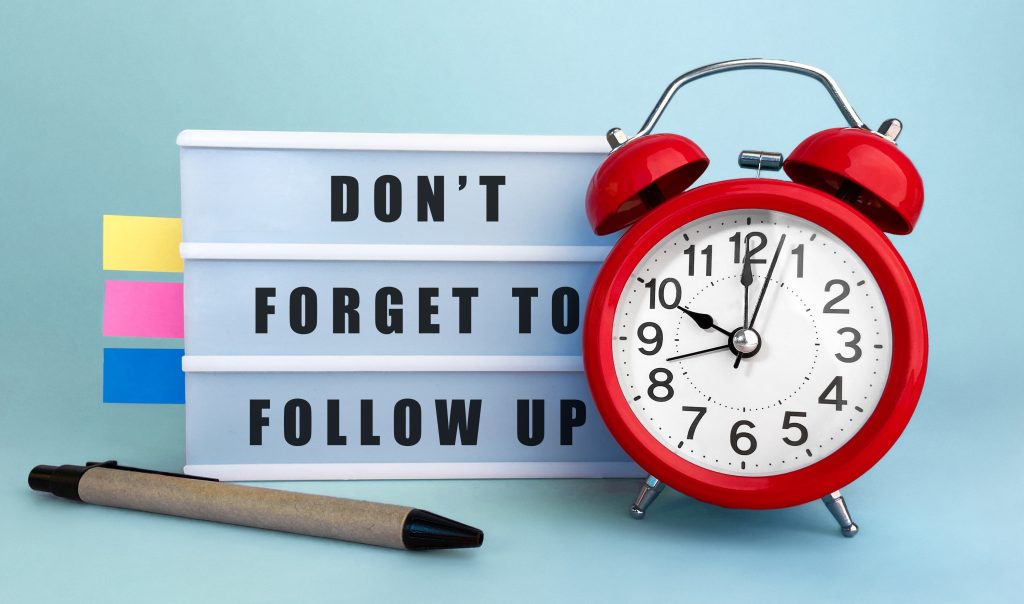Now that you have already found and researched your target audience and created your survey – all you have to do is send it out, right? Nope! You have already done so much work; now it is time to finish strong! A simple way to strengthen your study is by creating a follow-up plan. Research has found that sending one follow-up email can increase your response rate from 9% to 13%! This blog explores why follow-up is necessary and how to create an effective plan.
Why is follow-up necessary?
Initial surveys and follow-ups can be sent in a variety of ways. They can be done in person, via the phone, mail, or email. However, no matter which method you choose, your initial survey may only reach some of your intended participants. Often, mail is received and thrown away, email is sorted to junk, or phone calls are missed. Only some participants will fill out your survey on the first try. Thus, it is important to try again.
How does follow-up work?
The follow-up works in multiple ways; it will send reminders to those who have forgotten or ignored the first invitation, and it will be a second chance for a participant to see the invitation if they did not see it the first time Additionally, if you decide you have not gotten enough responses and want to add an incentive for participation, you can change it in the follow-up email. You can also use this time to reiterate to your participants why you value their feedback and want them to engage with your study. A follow-up is ultimately a second chance for everyone to provide the feedback that can help your organization grow. Communicating this information can further your chances of increasing your survey response rate.
How do you plan for it?
How will you create your follow-up plan? In a previous post, we went in-depth about getting things done through a five-stage method. This method can help your organization manage your follow-up plan and workflows. The five stages you can use to your advantage are:
1. Capture
Capturing what you need to get done. We provided examples of using a sticky note or to-do lists, so you have what you need to get done somewhere else other than in your brain. Laying out the necessary tasks can help you further plan and solidify your course of action. Include follow-up activities on your study timeline so your organization and team know it is coming up and when.
2. Clarify
Clarify what needs to get done. Now that you have captured that, you need to create a follow-up plan and clarify who will complete each task and how. Ask yourself, “How will my organization collect the data and keep track of who has completed the study and who has not?” Delegate these tasks before you send out initial surveys and follow-ups. Online survey platforms such as SurveyMonkey often provide tools that will help you send these out. If you are using staffing, they will need to know who has completed the survey and who has not. Be sure to include enough time to address this issue when you are designing your study. Even if you keep the survey results anonymous, ask participants for their email, name, or another identifying demographics to track who has completed the study.
3. Organize
This stage builds on your clarify stage by organizing how it will be done. For example, if you send a follow-up email, try writing it ahead of time and scheduling it to send out 48 hours after the first one. Scheduling when you will complete the follow-up process and having it organized and ready to go will standardize and ultimately streamline the process.
4.Reflect
This stage is about looking back at what you already completed. Have you captured, clarified, and organized correctly? Do you need to make any changes? Use this stage to review the hard work you have already implemented and decide if it has been sufficiently completed or if you may need to pivot and address any potential issues.
5. Engage
Engage is about taking action! Either implement your plan or make any changes that are needed. You have done all the hard work associated with planning; now it is time to put it into motion!
Email Follow-Ups
While there are more ways to follow-up, a common one is to send a reminder email. A follow-up email for a survey is most effective 42-78 hours after your first email. This gives your intended participants enough time from the first email not to annoy them, but it is also not too late for them to remember the first request. Furthermore, you want to keep the number of follow-up survey emails low, ideally between 2 and 4, because not everyone will want to participate in your study. We also recommend removing emails from your contact list if anyone reaches out and expresses that they are not interested in completing the survey.
When you send your follow-up, there are some quick tips for how to catch your participant’s eye. When scrolling through your emails, what makes you open a particular email? For 47% of people, that decision is based on the subject line. When you send a follow-up email, make your subject catchy! Make your email stand out from the countless others. If you are offering an incentive – put it in the subject line. This will motivate them to open it!
Another way to get participants to open your email is to personalize it. One study found that by personalizing an email, the open rate increases by 82%! Use the data you have to personalize your reminders. Make a plan with who will be responsible for this task and be able to send out personalized emails. It may seem like a lot of work initially, but with an increase of 82%, it will be well worth it.
Still have questions about follow-up?
Reach out to REC! We can help your organization implement effective follow-up to help raise your response rate!
Sources:
Financesonline. (2023). 52 Email Subject Line Statistics: 2023 Trends & Effective Ideas. Retrieved from Financesonline: https://financesonline.com/email-subject-line-statistics/
Kawalkowska, M. (2023). These Stats Prove The Importance of Follow-Up Emails. Retrieved from Woodpecker.co: https://woodpecker.co/blog/follow-up-statistics/
Pel Hughes. (2014). Tips to Effectively Track Survey Responses. Retrieved from Pel Hughes: https://pelhughes.com/tips-to-effectively-track-survey-responses/
ProProfs. (2023). Follow-Up Survey Email: How to Get More Responses in 2023. Retrieved from ProProfs: https://qualaroo.com/blog/customer-surveys-follow-up/#:~:text=Although%20the%20amount%20of%20reminders,may%20not%20take%20the%20survey.
Shtivelband, A. (2015). Getting Things Done. Research Evaluation Consulting LLC. Link: https://researchevaluationconsulting.com/time-managment-getting-things-done/
SurveyMonkey. (n.d.). Sending Reminder and Thank You Emails. Retrieved from SurveyMonkey: https://help.surveymonkey.com/en/surveymonkey/send/reminder-thank-you-emails/
Related Posts:
6 Tips to Collect Quality Data

